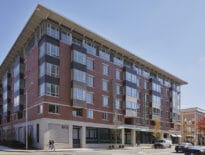
Stephen Whalen
As new developments spring up across Greater Boston, local officials and developers alike often tout the benefits projects can provide to the neighborhoods that surround them. Often, these take the form of additional revenue from property tax increases or linkage payments, as well as the affordable housing provided by residential developments.
However, one of the most overlooked opportunities is the role that retail can play in benefiting the community, particularly its lower-income members most often left out of the positives commercial development can bring. By being intentional and creative with commercial opportunities within new developments, developers can create mutually beneficial partnerships and allow a new generation to access this stepping-stone to the American Dream.
In most residential and mixed-use projects, the ground floor retail is often seen as an afterthought. The buildings are typically designed with one large space so that it can be simply leased to one national chain tenant as soon as possible and focus can shift back towards the residential portion of the project. But these large spaces are often well out of reach for local small businesses or new entrepreneurs, cutting off even established businesses from participating in the neighborhood’s development and depriving the surrounding communities of the benefits of thriving small businesses.

Cliff Kensington
Local Retailers Aid Placemaking
Studies have shown that more than 48 percent of money spent at local small businesses stays within the community, compared to just 14 percent at larger chains, with that disparity growing even larger for labor focused businesses such as restaurants. Redirecting resources towards these small businesses can have a significant multiplier effect on the entire local economy and create long lasting benefits for years to come.
By being slightly more intentional in designing a building’s retail space and carving out smaller sections within the retail portion, a new building can lower the barrier to entry for a small business to lease the space and gives local entrepreneurs a chance to incubate and build sustainable businesses in a brand-new space at a coveted location.
And the benefits of this approach are not just enjoyed by the people who own these businesses. For the community, these smaller spaces typically create more jobs per square foot than larger retail chains, while providing a more diverse range of services to the surrounding neighborhood. For the developer, these smaller businesses often demand less-intensive build-outs while having more, smaller tenants can mitigate the risk of any vacancies.
But truly, the largest impact can be felt in a building’s personality. Creating a wider range of offerings and pulling in more of the existing neighborhood character can make a building more attractive to future residents and give your project an identity. Having a large chain restaurant or drug store within walking distance is a nice feature, but it is the small markets, quirky boutiques, cozy cafes and inventive restaurants that truly make a neighborhood memorable.
Leases Also Offer Tools
In many of City Realty’s recent projects, we have implemented programs to help local businesses that go beyond just designing smaller spaces. We have worked to develop creative solutions in our commitments to the communities we work with that create long lasting benefits. In some projects, we have set aside a portion of our retail square footage at affordable, below-market rents just as we do for our residential units. In other projects, our mitigation has taken the form of grants paid by the development to help a local business get established within the new building.
But even in the absence of any kind of binding commitment or deed restriction, there are still plenty of tools to make new development more entrepreneur-friendly. We have worked with local business groups and “Main Street” organizations to proactively identify local businesses looking to expand and give them a first look at the new spaces before they hit the wider market. We have also gotten creative with lease structures, utilizing free rent periods or significantly lowering up-front rent with larger increases in future years to give our business tenants a chance to get off the ground while still eventually hitting our projected income.
Entrepreneurship is a powerful tool for closing the wealth gap in our country and for energizing a neighborhood’s local economy. And with a little creativity, new development can be a major catalyst in stimulating this growth and allowing new businesses to thrive. By pulling in the talent, creativity and vibrancy of the surrounding community, a new building can integrate itself into the neighborhood’s character and become a major driver of its future success.
Stephen Whalen is managing partner and Cliff Kensington is director of acquisitions at Boston-based developer City Realty Group.






